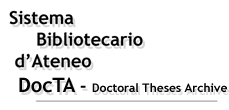|
|
DocTA - Doctoral Theses Archive >
Tesi di dottorato >
CORSO DI DOTTORATO IN SCIENZE DELLA PERSONA E DELLA FORMAZIONE >
Citazione:
Utilizza queste indicazioni per citare o creare un link a questo documento.
|
Manzi, Federico. "'MATERIALITY AND THE CONSTRUCTION OF INTERSUBJECTIVITY. HUMAN-ROBOT INTERACTION IN TYPICAL DEVELOPMENT AND THE USE OF THE OBJECTS IN ASD CHILDREN'", Università Cattolica del Sacro Cuore, XXXI ciclo, a.a. 2017/18, Milano, [http://hdl.handle.net/10280/84495].
|
| Titolo: | 'MATERIALITY AND THE CONSTRUCTION OF INTERSUBJECTIVITY. HUMAN-ROBOT INTERACTION IN TYPICAL DEVELOPMENT AND THE USE OF THE OBJECTS IN ASD CHILDREN' |
| Autore/i: | MANZI, FEDERICO |
| Tutor: | MARCHETTI, ANTONELLA |
| Coordinatore: | MARCHETTI, ANTONELLA |
| Lingua: | ENG |
| Abstract in italiano della tesi: | Gli obiettivi della presente tesi sono di analizzare, nei bambini con sviluppo tipico e atipico, la costruzione dell'intersoggettività attraverso l'uso di oggetti nello sviluppo atipico (ASD) e attraverso l'interazione con un robot umanoide nello sviluppo tipico. Per quanto riguarda i robot umanoidi, il problema è osservare la possibile attribuzione di caratteristiche simili all'uomo a un robot che possa rendere l'interazione uomo-robot simile all'interazione uomo-uomo che è una classica interazione intersoggettiva per la presenza di due soggetti umani. Questo scopo viene indagato considerando due quadri teorici: 1) la Teoria della Mente che spiegano la costruzione dell'intersoggettività attraverso l'attribuzione di stati mentali ad altri; 2) Prospettiva socio-materiale che postula che in molti casi la costruzione dell'intersoggettività sia mediata dagli oggetti. Quindi, la domanda che sorge in questa dissertazione sui robot umanoidi è: cosa succede quando l'oggetto mediatore (il robot) è anche il partner interattivo.
Per raggiungere questo scopo, la presente tesi investiga due temi principali: 1) i modelli di interazione con e l'attribuzione di una mente a un robot da parte di bambini con sviluppo tipico; 2) i modelli di interazione nello sviluppo atipico - bambini autistici - in un'interazione bambino-adulto mediata da oggetti. Il primo tema viene analizzato in una prospettiva teorica e un approccio metodologico innovativi, che porta a una comprensione dell'interazione bambino-robot. La prospettiva teorica collega il ruolo della Teoria della Mente alll'HRI; l'approccio metodologico osserva le strategie decisionali dei bambini nell'HRI, confrontando questi modelli comportamentali quando i bambini interagiscono con un essere umano e con un robot. Il secondo tema della tesi riguarda il ruolo dell'oggetto come mediatore della relazione tra bambini autistici e adulti. Questo viene studiato attraverso la prospettiva socio-materiale che suggerisce che le caratteristiche materiali degli oggetti e le loro qualità sociali intrinseche siano strettamente connesse. |
| Abstract in inglese: | The aims of the present dissertation are to analyse, in children with typical and atypical development, the construction of the intersubjectivity through the use of objects in atypical development (ASD) and through the interaction with a humanoid robot in typical development. About the humanoid robots, the issue is to observe the possible attribution of human-like features to a robot that can make the human-robot interaction similar to the human-human interaction that is a classic intersubjective interaction because of the presence of two human subjects. This purpose is investigated considering two theoretical frameworks: 1) Theory of Mind that explain the construction of the intersubjectivity through the attribution of mental states to others; 2) Socio-material perspective which postulates that the construction of the intersubjectivity is mediated by objects in many cases. Thus, the question arises in this dissertation about the humanoid robot is: what happen when the mediator object (the robot) is also the interactive partner.
To achieve this purposes, the present thesis studies two main topics: 1) the interactional patterns with and the attribution of a mind to a robot by typically developing children; 2) the interactional patterns in atypical development - autistic children - in a child-adult interaction mediated by objects. The first topic is analysed in an innovative theoretical perspective and a through novel methodological approach, leading to an innovative understanding of the child-robot interaction. The theoretical perspective connects the role of Theory of Mind in HRI; the methodological approach observes children’s decision-making strategies in the HRI, comparing these behavioural patterns when children interact with a human and with a robot. The second issue of the thesis is about the role of the object as mediator of the relationship between autistic children and adults. This is studied through the Socio- material perspective that hypothesised that material features of the objects and their intrinsic social qualities are strictly connected. |
| Data di discussione: | 4-dic-2018 |
| URI: | http://hdl.handle.net/10280/84495 |
| È visualizzato nelle collezioni: | CORSO DI DOTTORATO IN SCIENZE DELLA PERSONA E DELLA FORMAZIONE
FACOLTA' DI SCIENZE DELLA FORMAZIONE
|
File in questo documento:
| File |
Descrizione |
Dimensioni | Formato | Accessibilità |
|---|
| Tesi_Dottorato_Federico_Manzi.pdf | Tesi_Manzi_PDf | 1,07 MB | Adobe PDF | non consultabile
|
|
Accesso e utilizzo dei contenuti di DocTA
|



